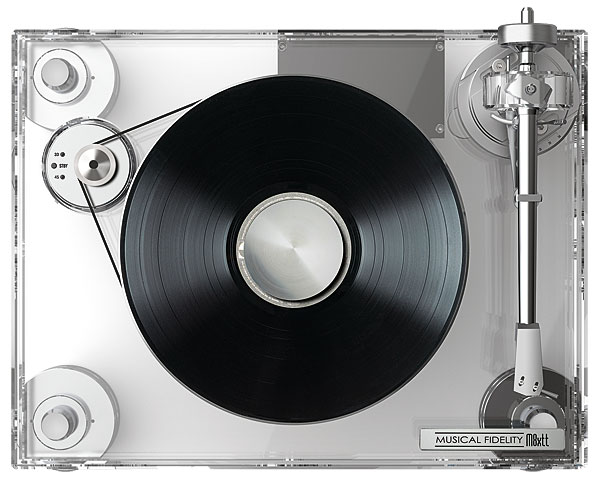Musical Fidelity M8xTT Turntable

 Inspired by Musical Fidelity's statuesque, near all-acrylic M1 turntable from 2004, the brand's new owners have reimagined the design to partner its massive Nu-Vista amps
Inspired by Musical Fidelity's statuesque, near all-acrylic M1 turntable from 2004, the brand's new owners have reimagined the design to partner its massive Nu-Vista amps
There can be no doubt that retro is 'in'. From cars to kitchen appliances to hi-fi, many manufacturers are taking inspiration from the past and bringing famous and fondly remembered designs into the 21st century. The acquisition of the Musical Fidelity brand back in 2018 by Heinz Lichtenegger's Audio Tuning Vertriebs GmbH has given the company a very extensive and highly capable back-catalogue to mine. As a result, Audio Tuning (parent of the ubiquitous Pro-Ject marque), has taken the opportunity to boost its portfolio with a spot of retro fever.
In addition to the obvious choice of a re-birth of the classic A1 amplifier [first full technical review next month] and the 'left-field' development of BBC-style LS3/5A and LS5/9 loudspeakers, Lichtenegger has wisely chosen to focus on the top-end of Musical Fidelity's historic lineup. The huge Nu-Vista amplifiers were the first fruits of this endeavour [HFN Mar & Aug '23], but the latest release is a re-working of a somewhat lesser-known Musical Fidelity creation – the M1 turntable [HFN Mar '04] – in the form of the £8249 M8xTT.
Bigger Boots
The basic construction of the M8xTT will be familiar to anyone who has encountered an M1. The plinth consists of two layers of clear acrylic that sit at different levels on four specially-designed aluminium feet. These are both 'magnetically supported' and damped with a soft TPE polymer. Unlike the original M1's feet, the M8xTT's bigger boots comprise two parts and are adjustable to level the deck – they support both layers of the acrylic plinth but have Teflon spacers in-between which help isolate the two slabs.
The turntable motor sits in a special foam gasket on the lower plinth and locates in a cut-out within the upper layer without making any physical contact. The supplied DC PSU connects directly to the motor unit and a clean sinewave is regenerated inside the assembly to run the motor, which is an AC type. A future upgrade option is in the pipeline, in the form of an outboard, higher specification linear DC PSU. Drive is transferred to the lower platter's edge via a precision-ground silicone belt.

Operation is simplicity itself, with a single switch on the motor pod starting and stopping the platter and selecting the speed. The switch button illuminates green on power-up, indicating that the deck is in standby mode. Short presses then toggle the setting between 33.3 or 45rpm, each with an indicative blue LED that flashes until the platter is up to speed, then illuminates steadily. A longer press returns the deck to standby mode and stops the platter.
The platter itself is a substantial affair, tipping the scales at 10kg. It consists of two layers of aluminium with aluminium inserts in-between, which recalls the M1's two-layer acrylic platter with its peripheral weights. Both top and bottom layers are damped with more TPE and a rather swish leather platter mat is supplied as standard. An aluminium record puck weighing in at 315g presses the record into this mat.
The arm mounted on this deck is a 10in design and, while it bears a superficial resemblance to existing Pro-Ject tonearms, it is actually all-new for the M8xTT. Most obvious is a large Plexiglass/acrylic bearing housing that is hand-polished and annealed. The armtube is tapered and precisely machined from a single piece, and is adjustable for azimuth. The armbase has a distinctly SME-like appearance and the whole arm mount can be slid backwards and forwards by 20mm when two large Allen bolts are loosened. Pro-Ject also suggests that a range of armbases will be available in due course to accommodate alternative arms.
Keeping Track
Two counterweights are provided that will balance cartridge bodyweights of between 6-20g, and both are TPE-damped and isolated from the threaded adjuster to minimise resonances. The setup is not calibrated, however, so a good stylus balance – perhaps Pro-Ject's £20 Measure it E – is a must for setting tracking force. Bias is applied by the thread and weight system, and a support rod for the thread is fitted to the bearing housing.
The M8xTT's arm features a standard 5-pin output socket and requires the connection of a short flying lead from the termination box located on the lower plinth during assembly. This junction box offers outputs in both balanced XLR and unbalanced RCA formats, plus a ground terminal. Fit and finish of the turntable is nothing short of outstanding but, when setting up your cartridge, be aware that the headshell lacks sufficient offset angle so you'll need to rotate your MM or MC slightly inwards.
![]() A View To A Thrill
A View To A Thrill
With the deck set up and my Clearaudio MC Essence pick-up [HFN Aug '17] installed, I was reminded of a quip made by editor PM when I arrived to collect it. He had mused whether it would sound quite as solid yet transparent as it looks. It turns out that he was spot on. The M8xTT presents a beautifully open window onto the performance, but it achieves this in a commandingly authoritative manner. The old M1 was always a little soft at the low end; in this respect, Musical Fidelity's new model couldn't be more different.


















































